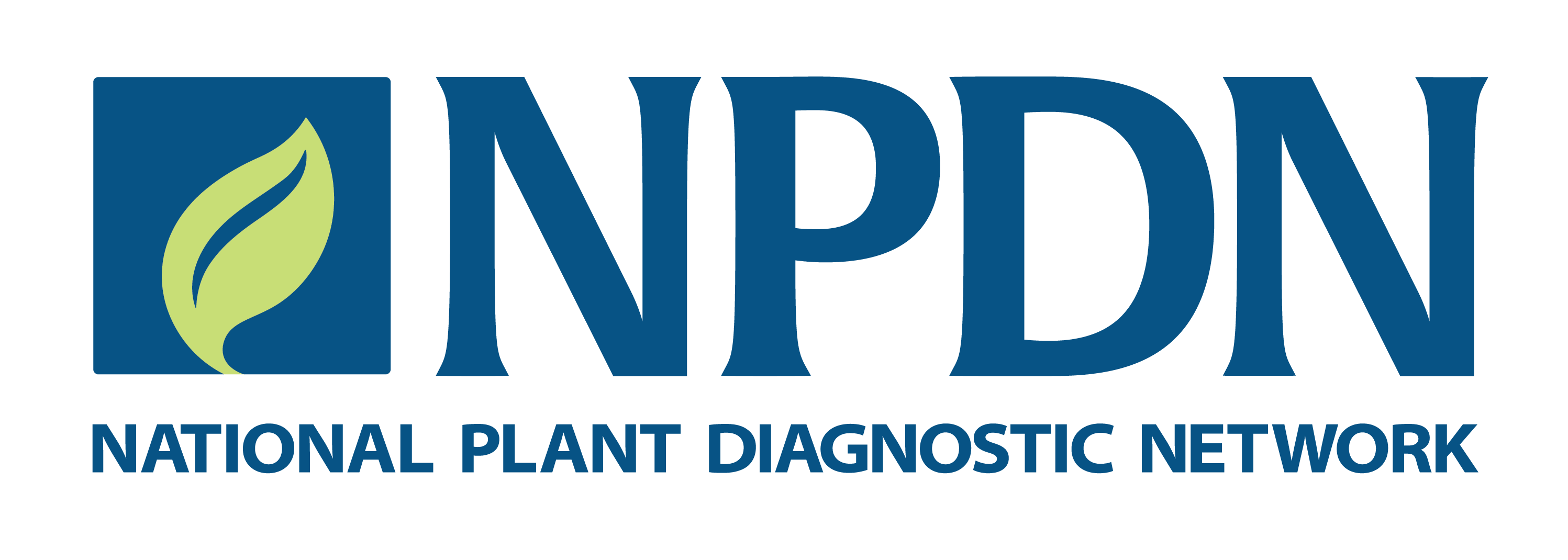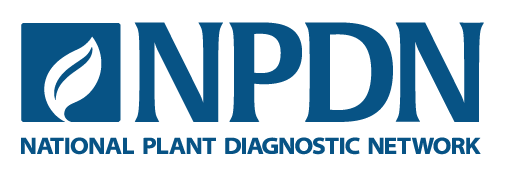Megan Romberg, National Mycologist/Plant Pathologist, USDA-APHIS
Edited and reviewed by Sara R. May* The Pennsylvania State University (NEPDN), Lina Rodriguez Salamanca* Virginia Tech (SPDN); Karen Rane** Emeritus diagnostician University of Maryland (NEPDN)
*Member of the NPDN Protocols and Validation Committee
** Member of the NPDN National Data Committee
The Communicator: Volume 6, Issue 6, June 2025
When you have a sample exhibiting fungal growth, or symptoms caused by fungi, and you don’t know where to start, a few techniques and resources can help get you closer to an identification. These can be summarized in the four steps listed below.
ONE: Determine the host and the fungal group associated with the symptoms.
(see Mycolog.com and the resource list at the end of this article)
Main fungal groups you’ll likely see:
- Ascomycete asexual states (Coelomycete, Hyphomycete)
- Ascomycete sexual state
- Basidiomycete (rust or smut, butt rot/wood rot fungi)
- Oomycete (downy mildew, white rust, Phytophthora-like)
TWO: Use databases and literature to narrow down the possibilities.
- “The big red book” (Fungi on Plants and Plant Products in the United States) organized by host and fungal group as listed above (outdated by several decades but still useful)
- Host lists in the back of group-specific resourcese.g. The Coelomycetes (Sutton), or Manual of the Rusts in United States and Canada (Arthur and Cummins)
- Fungus-host databases Excel sheet*
- Page through group-specific resources e.g. The Genera of Hyphomycetes (Seifert, et al), Smut Fungi of the World (Vanky)
- Google Scholar search type in “host” and “group” (e.g. “Solidago” and “Rust”)
- Crop specific resources e.g. APS compendia or Diseases of Trees and Shrubs (Sinclair and Lyon)
THREE: Compare options to your unknown sample and get to a tentative name.
Make a list of what you could have based on the resources in TWO. If it’s a coelomycete for example, which ones can you rule out because the conidia or fruiting bodies don’t look at all like yours?
- Use Mycobank to look for literature containing descriptions of unfamiliar names.
- Search an unknown name in Google Scholar with terms like “taxonomy” or “phylogeny”
FOUR: Verify the name based on current nomenclature and taxonomy.
- Mycobank has information on nomenclature and links to literature, including in some cases illustrations and original descriptions (through Index Fungorum).
- The USDA Fungal Databases Nomenclature Search tab has up-to-date information on synonyms.
More detail on each step:
- Examine the sample under a dissecting microscope as thoroughly as you can. A 10X to 30X hand lens can also be helpful to look closely at structures you think might be caused by fungi. Try using a flashlight or other oblique light and play with the lighting on the sample to look for subtle changes in the color and surface of the sample. Use what you see to determine what group of fungi you might be dealing with. (See step 2.)
- Prepare a slide to do some exploration of the symptomatic tissue. Place a small drop of mounting medium on one side of a slide. Water is commonly used, but 85% lactic acid or 50% glycerol dry much more slowly and can give you more time to work with the sample. They also are more conducive to using a warming plate, which can really help soften tissues and hydrate dried-out fungal structures.
- While looking under the dissecting microscope, either remove evident fungal tissue or scrape gently across symptomatic regions with a scalpel blade. You might dislodge fungal structures in this way or reveal fruiting bodies hiding just underneath the epidermis. Tap the scraped-off tissue into the mounting medium, checking under the dissecting microscope to make sure you’ve actually moved the tissue from the scalpel to the medium.
- Warm your slide at 50°C, (120°F) for about 5 minutes (up to a few hours is ok, especially if using lactic acid). A mug warmer could be used for this if your lab doesn’t have a warming plate.
- While your slide is warming, try to come up with some possible identification paths for your unknown.
- What group of fungi could you be seeing? Is it an ascomycete asexual state (coelomycete or hyphomycete)? Is it an ascomycete sexual state? A rust or smut?
- Start with
- “The big red book” (Fungi on Plants and Plant Products in the United States)
- The static Excel file from the “old” USDA fungus host databases (data up to 2022)
- The USDA Fungal Databases
- Crop specific compendia
- Under the compound microscope, scan your slide under 4X or 10X to find fungal structures. Lowering the light might help you see the outline of small spores or fruiting bodies. Increase the light slowly as you increase objective strength.
Ask two important questions:
- What do the spores look like? (shape, size, septation, appendages?)
- Where are they coming from? (Directly from hyphal structures like conidiophores? From fruiting bodies (e.g. pycnidia)? From asci?)
- Begin the iterative process of comparing what you are seeing under the microscope to images or illustrations of fungi from your tentative list in Step 2.
Resources to start with based on the structures seen
If you see:
Cushions of spores on the leaf surface, especially if yellow, orange, or brown AND spores with spikes or large brown spores
Try this book first: Manual of Rusts in the United States and Canada
If you see:
Lots of powdery dark spores OR light-colored lesions with spores that have thick walls but are barely distinguishable from plant cells
Try this book first: Smut Fungi of the World
If you see:
Globose, pear-shaped or cup-shaped fruiting bodies with asci present
Try this book first: Illustrated Genera of Ascomycetes
If you see:
Globose, pear-shaped, irregular or saucer-shaped fruiting bodies with masses of spores present
Try this book first: The Coelomycetes
If you see:
Spores produced on specialized hyphal structures or directly on hyphae
Try this book first: The Genera of Hyphomycetes
Generally Useful Websites
MNGDBL Fungus Host databases
Mycoportal
Mycobank Includes links to Index Fungorum and other websites.
Cyberliber scans of literature, sometimes obscure
Westerdijk Institute especially the publications pages, including all of the Studies in Mycology
Ascofrance This is a website of ascomycete aficionados in Europe, mostly amateurs. It helps to read French, German and Spanish to navigate some of the posts, but they often have fantastic images.
Pest and Disease Image Library (Australia) images of a variety of fungi and other organisms
Bugwood network images
NZFungi Contains information on specimens in the New Zealand national collections, along with images for some.
CABI Descriptions of fungi and bacteria
Fungi Canadenses descriptions of specific fungi
Pyrenomycetes of the World
GOPHY Genera of Phytopathogenic Fungi
ID Tools A USDA resource for images and factsheets
Mycolog.com lots of information about different groups of fungi with illustrated examples
Books
Various Fungi
Kirk, P.M., Cannon, P.F., Minter, D.W., and Stalpers, J.A. 2008. Dictionary of the Fungi 10th Ed. CABI (IMI, Kew, England).
*Ellis, J.P. and Ellis, M.B. 1997. Microfungi on Land Plants: An Identification Handbook. Richmond Publishing.
Piepenbring, M. 2015. Introduction to Mycology in the Tropics. APS Press.
Ulloa, M. and Hanlin, R.T. 2012. Illustrated Dictionary of Mycology (2nd Ed.). APS Press.
Hyphomycetes
*Chupp, C. 1954. A monograph of the fungus genus Cercospora. Ithaca, New York. Published by the author.
^Ellis, M.B. 1971. Dematiaceous Hyphomycetes. CABI (IMI, Kew, England).
^Ellis, M.B. 1976. More Dematiaceous Hyphomycetes. CABI (IMI, Kew, England.
Seifert, et al. 2011. The Genera of Hyphomycetes. CBS-KNAW (Netherlands).
Coelomycetes
Raj, N. 1993. Coelomycetous Anamorphs with Appendage-Bearing Conidia. Mycologue Publications Canada.
Sutton, B.C. 1980. The Coelomycetes. CABI (IMI, Kew, England).
Ascomycetes
Hanlin, R.T. 1990. Illustrated Genera of Ascomycetes Volumes I and II. APS Press.
*Sivanesan, A. 1984. The Bitunicate Ascomycetes and their Anamorphs. Cramer, Vaduz.
Braun, U. and Cook, R.T.A. 2012. Taxonomic Manual of the Erysiphales (Powdery Mildews). CBS
Guarro et al. 2012. Atlas of Soil Ascomycetes. CBS
Basidiomycetes (rusts and smuts)
*Arthur, J.C., Cummins, G.B. Manual of the Rusts in United States and Canada. 1962. Hafner Publishing New York.
Cummins, G.B., Hiratsuka, Y. 2003. Illustrated Genera of Rust Fungi APS Press.
Cummins, G.B. 1971. The Rust Fungi of Cereals, Grasses and Bamboos. Springer-Verlag.
*Cummins, G.B. Rust Fungi on Legumes and Composites in North America. University of Arizona Press.
*Vanky, K. 2012. Smut Fungi of the World. APS Press.
*Available for download under the Pest Identification Resources tab on the Outreach and Extension page of the NPDN website (login required).
^Available at Internet Archive

